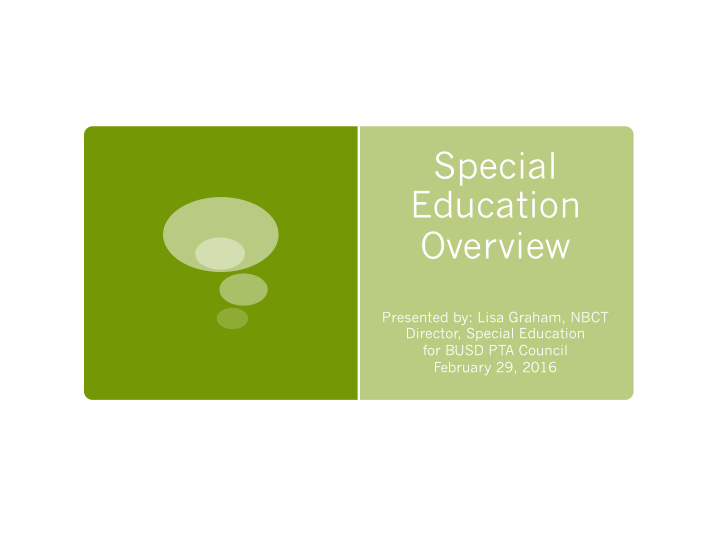



Special Education Overview Presented by: Lisa Graham, NBCT Director, Special Education for BUSD PTA Council February 29, 2016
Agenda § Framework for BUSD’s decision to transition to an inclusive education model § Research evidence to support inclusion § What is Special Education? § How many BUSD students have an IEP? § What is a 504? § How can I get more information? § Questions & Answers
Philosophy of Inclusion “Inclusive education is really about fostering an education system that is accessible to children of all ability levels and embraces the participation of the whole community in the education process.” - Nathaniel Stewart, Peace Corps Volunteer
Context of Inclusion in BUSD § In 1993 the District formed the Inclusive Education Taskforce to develop the implementation of inclusive education § In 2003 Dr. Kathleen Gee & Dr. Diane Ketelle conducted a comprehensive Special Education study § The findings and recommendations from this report were presented to the BUSD Board to assist in the strategic development and planning for the District
Benefits of Inclusion § Time spent engaged in the general education curriculum is strongly and positively correlated with math and reading achievement for students with disabilities (Cole, Waldron, & Majd., 2004; Cosier, Causton-Thoeharis & Theoharis, 2013) § Students without disabilities made significantly greater progress in reading and math when served in inclusive settings (Cole, et.al., 2004)
Benefits of Inclusion § Students with autism in inclusive settings scored significantly higher on academic achievement tests when compared to students with autism in self-contained settings (Kurth & Mastergeorge, 2010) § Students with intellectual disabilities that were fully included in general education classrooms made more progress in literacy skills when compared to students served in special schools (Dessemontet, Bless, & Morin, 2012)
Service delivery § IDEA ‘97 – confirms standards for ALL students as being General Education curriculum and rigorous instructional practices in the LRE with typical peers § Statewide Taskforce on Special Education recommends an Inclusive Educational setting for all students § BUSD has implemented systemic Inclusive Educational practices since 2004 § Related services are provided to students at their school site § Nonpublic School or State Special School programs for very few students who require an alternative educational setting
What is Special Education? § Free Appropriate Public Education (FAPE) for eligible students with a disability who require Special Education services and supports § Specialized Academic Instruction § Related Services as needed § Provided at no cost to the parent/ guardian § Provided in the Least Restrictive Environment (LRE) (ie General Education setting with typical peers)
Eligibility – 2 prongs § Identified by an individual education program (IEP) team as a child with a disability in one or more of the 13 federal categories AND § Their impairment requires instruction and services which cannot be provided with modification of the regular school program in order to ensure that the individual is provided a free appropriate public education (FAPE)
13 Federal Categories § Characteristics associated with Autism § Deaf § Deaf-Blind § Emotional Disturbance § Hard of Hearing § Intellectual Disability § Multiple Disabilities § Other Health Impaired § Orthopedic Impairment § Specific Learning Disability § Speech or Language Impaired § Traumatic Brain Injury § Visual Impairment including Blindness
Eligibility exclusionary factors Pupils whose educational needs are due primarily to: § Limited English proficiency § Lack of instruction in reading or math (“per NCLB”) § Temporary physical disabilities § Social maladjustment § Environmental, cultural, or economic factors are not individuals with exceptional needs
“Rowley” Standards § Establishes definition of “appropriate” in FAPE for Special Education § Provides students a basic floor of opportunity § Reasonably calculated to provide some educational benefit § School Districts are not required to maximize educational benefit to allow a child to realize his or her potential
2015-16 demographics § Students age birth-22 years old are served in Special Education § SpEd Pupil Count as of 12/1/15 = 1,070 § Total enrollment as of 10/06/15 = 9,824 § SpEd=10.89% of K-12 General Education § Fastest growing populations are Pre-K and Autism, a continuing upward trend since 2011
What is a 504? § Under Section 504 of the Rehabilitation Act, a “person with disabilities” is any person who has a physical or mental impairment which substantially limits a major life activity (ie learning). § “Substantially limits” means unable to perform a major life activity that the average person in the general population can perform.
504 in relation to IDEA All Students Section 504 Students IDEA (SpEd) Students
For more information: § For more information regarding Special Education services please feel free to contact: § Lisa Graham, NBCT § Lisagraham@berkeley.net § 510.644.7733 § http://www.berkeleyschools.net/ departments/special-education/ § Questions Welcomed
Recommend
More recommend